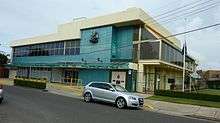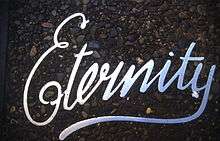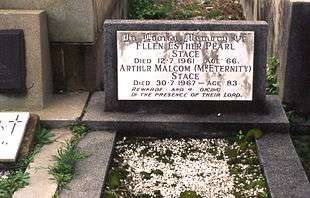Matraville, New South Wales
| Matraville Sydney, New South Wales | |||||||||||||
|---|---|---|---|---|---|---|---|---|---|---|---|---|---|
|
Matraville town centre | |||||||||||||
| Coordinates | 33°57′41″S 151°13′53″E / 33.9613°S 151.2315°ECoordinates: 33°57′41″S 151°13′53″E / 33.9613°S 151.2315°E | ||||||||||||
| Population | 9,039 (2011 census)[1] | ||||||||||||
| Established | 1904 | ||||||||||||
| Postcode(s) | 2036 | ||||||||||||
| Location | 9 km (6 mi) south-east of Sydney CBD | ||||||||||||
| LGA(s) | City of Randwick | ||||||||||||
| State electorate(s) | Maroubra | ||||||||||||
| Federal Division(s) | Kingsford Smith | ||||||||||||
| |||||||||||||
Matraville is located in the Eastern Suburbs of Sydney, in the state of New South Wales, Australia. It is approximately 9 km (6 mi) by road south-east of the Sydney central business district, in the local government area of the City of Randwick.[2]
History
Matraville is named in honour of James Matra (1746–1806), an American sailor and diplomat, who was a midshipman on the voyage by Captain James Cook to Botany Bay in 1770.[3] Matra was born in New York, but later settled in England. Matra had walked over the area with Cook and his close friend, botanist Joseph Banks. Matra had proposed to the British government that it establish a colony at Botany Bay in 1783, which he envisaged could be a place that American loyalists could also settle.[4]
Matraville was originally reserved for the Church and Schools Corporation with income generated intended to support clergy and teachers. The school was established in 1904, thanks to the efforts of John Rowland Dacey, the state member for Botany, who had nearby suburb of Daceyville named after him. The school was originally known as Cross Roads but Dacey suggested that the name Matra would be more appropriate in honour of James Matra.[5] Dacey's suggestion was accepted by the Department of Education and the school and suburb became Matraville. The land at Matraville reverted to the crown in 1917 and 72.5 acres (29.3 ha) were allocated for a settlement for soldiers returning from World War I. This parcel became one of the first large residential developments in the area – between 1918 and 1925. The Voluntary Workers Association was formed to build homes for soldiers and their families at the intersection of Anzac Parade and Beauchamp Road. The first cottage at the settlement was completed in 1919 and the residential area became known as Matraville Soldiers Garden Village.[6] A total of ninety-three cottages were built between 1918 and 1925. They were eventually taken over as State Government public housing. In 1977, all the cottages except one were demolished in spite of public protest; the one remaining cottage can still be seen in Somme Way. All that is left of the other cottages is a park with sections of sandstone walls and foundation stones laid by a number of people, including then Prime Minister William Morris Hughes.[7] Matraville was gazetted as a postal area in 1911.
Matraville is a suburb steeped in ANZAC history. Matraville Soldiers' Settlement Public School is surrounded by roads commemorating the battlefields of World War I. These include Amiens, Ypres, Pozieres, Beauchamp, Menin, Flanders, Amiens, Bullecourt, Bapaume, Hamel, Armentieres inter alia. One street is Lone Pine Pde, referring to the bloody battle at Gallipoli where more than 2000 Australians died. Pozieres Ave, commemorates the battle during World War I, where Australia lost as many men in six weeks as they did in the whole of the Gallipoli campaign. Other streets in the area are named after rivers, Torrens, Franklin, Namoi, Hunter, Clarence and also early Australian explorers, Cunningham, Blaxland, Lawson and Oxley. HMAS Oxley was an Oberon class submarine in the Royal Australian Navy.[8] Matraville was split between Randwick and Botany Councils. When problems arose from the division in 1961, Botany Council decided to rename its portion Gilmore, to honour Australian poet Mary Gilmore (1864–1962). After the post masters general office pointed out that there already was a Gilmore, New South Wales (near Tumut), the council chose Hillsdale to honour Patrick Darcy Hills, who was the New South Wales minister for local government. It was a controversial choice since most residents believed that a name should have been chosen that reflected Australia's history.[9]
Matraville was one of the last bastions of traditional Chinese market gardens which is listed on the State Heritage Register. Until 1859 market gardens in the district were owned and tended by Europeans. After the main wave of gold rushes in the 1850s Chinese workers moved into the district. By the 1920s Chinese market gardens across NSW were being squeezed out by larger scale, more modern agriculture. The gardens at Matraville continued into the 1970s when leases were rescinded by the Crown. Despite opposition from Randwick Council and local residents the gardens were bulldozed to make way for housing development.[10]
Matraville was once home to a coal-fired power plant, which was demolished in the 1980s to make way for further Port Botany expansion and a State Transit Authority bus depot, which provides services from the peninsula to the city. The only remaining part of the Bunnerong power station is called 'the Sucko', due to the 'sucking' inlet valve for water to cool the power plant.[11] It is a popular swimming spot. In 1934 the fourth section of the La Perouse tramline was built to the power station which helped to encourage residential and industrial growth in the area.[12]
Commercial areas
Matraville is primarily a residential area. The area has predominately low-rise housing but there is also a diverse range of retail, commercial and recreational uses. Approximately 52 per cent of all private dwellings in Matraville are separate houses, significantly higher than the Randwick City average (28 per cent).[13]

The Matraville shopping centre is located in Bunnerong Road, between Beauchamp Road and Franklin Street. It offers shopping and a variety of dining experiences.[14] There is a newly renovated Matraville Hotel and the Matraville RSL both offering contemporary Australian cuisine as well as live entertainment.
The suburb has experienced gentrification largely due to its proximity to Sydney's CBD, its famous beaches and the University of NSW all of which have resulted in an increased demand for homes in the area.[15]
Landmarks

Landmarks include Heffron Park, a large reserve bordering Maroubra, formerly the site of a naval stores base in World War II. Eastern Suburbs Memorial Park sits along the southern border of the suburb and incorporates Botany Cemetery, Eastern Suburbs Crematorium and Pioneer Park.[16] Arthur Stace, known in Sydney as Mr Eternity, is buried at Botany Cemetery. He was famous for his practice of writing the word Eternity all over Sydney during the fifties and sixties.
Churches
Matraville is home to St Agnes Catholic Church and Matraville Baptist Church.[17] Matraville also has a large Jehovah's Witness congregation with a Kingdom Hall.[18]
Schools
There are two primary schools, one public and one Catholic and Matraville Sports High School.[19] A child care centre and preschool is also in the suburb. Matraville Soldiers Settlement School previously had a separate Infants and Primary School which are now combined into one larger school following the acquisition of park land at Finucane Crescent.
Transport
Matraville is located 9 km (6 mi) from Sydney CBD and 3 km (2 mi) along Bunnerong Road from Kingsford town centre. Sydney Bus routes operate to City – Central Railway station, Martin Place and Circular Quay via Bunnerong Road, Anzac Parade (UNSW), and Oxford Street
Sport and recreation
Heffron Park bounded by Bunnerong Road, Jersey Road, Robey Street and Fitzgerald Avenue comprises many sporting facilities including The Matraville Sports Centre with its squash and tennis courts.[20] The recently updated Des Renford Leisure Centre has a gym, a crèche, an indoor heated pool, an outdoor Olympic sized pool and 2 pools for juniors[21] The Heffron Park sporting fields are set in extensive grasslands with a 4.2 km (2.6 mi) bicycle track that weaves through the entire park. The park also provides opportunities for passive recreation such as walking, jogging, kite flying and ball games.In addition nearby Matraville RSL club, provides activities such as lawn bowls, social golf, tennis, darts and snooker.[22] The Malabar Riding school is located on Wassel Street near the Chinese Gardens. Matraville Sports High School's Rugby League Program is one of the fastest growing in schoolboy Rugby League.[23]
Matraville is close to some of Sydney's well-known beaches such as Maroubra Beach and Coogee Beach, Long Bay, Little Bay and the more sedate and secluded Congwong Beach.[24] near the mouth of Botany Bay. Sydney Dive Academy is based at Matraville, just north of one of Sydney's scuba diving locations, Bare Island.[25][26]
Culture
The Star Drive-in theatre opened in August 1958 and operated until 8 August 1984 when it closed for the last time because it was no longer profitable. No fanfare greeted the last screening and only nine cars were there to view the last film screened, The Exterminator.[27] Drive-ins have featured in many Australian films. The best known is movie Dead End Drive-In (1986), a satirical futuristic action film in which troublesome youth, the unemployed and unwanted immigrants are herded into a drive-in converted into a detention centre. Filming took place at Sydney's Matraville Drive-in. The Matraville Drive-in was demolished shortly after movie was completed, joining the hundreds of Australian drive-ins to suffer a similar fate in the 1980s. Matraville also hosts a very large Christmas lights decoration in the areas around Flanders Avenue, Knowles Avenue, Franklin Street, Clarence Street and Barwon Crescent.
Demographics
According to the 2011 Australian Bureau of Statistics Census the population of Matraville is 9,039: 48.3% male and 51.7% female. The median age of the Matraville population is 40 years of age, 3 years above the Australian average. 48.5% of people are married, 34.4% have never married and 7.3% are separated or divorced.[1]
Of the total population in Matraville, 59.7% stated they were born in Australia. Other common responses were United Kingdom 3.0%, China 2.9%, New Zealand 2.4%,Hong Kong 1.7%, Indonesia 1.5%.[1]
English was stated as the only language spoken at home by 63.7% of residents followed by Cantonese 4.8%, Greek 3.2%, Mandarin 2.9%, Italian 2.5%, Spanish 2.4%. The most common responses for religious affiliation were Catholic 40.1%, Anglican 14.5%, No religion 10.6%, non-Christian 8.7%, Orthodox 5.7% and Judaism 2.9%.[1]
As far as occupation is concerned, residents surveyed come from all walks of life, ranging from the professionals and managers (28.6%), clerical and administrative workers (19.2%) to technicians and trades workers (15%).[1]
Notable people
- Bob Carr Foreign minister of Australia and former Premier of New South Wales. The first dux of Matraville High School in 1964
- Sandor Earl Rugby league player went to Matraville High[28]
- James Tamou Rugby league player went to Matraville High[29]
- Michael Atherton. Emeritus Professor and composer-performer attended Matraville High School 1965–1966
Gallery
- St Agnes's Catholic Church, Bunnerong Road
- Cottage in Somme Way, the only surviving cottage from the soldiers' settlement
 Grave of Arthur Stace, Botany Cemetery
Grave of Arthur Stace, Botany Cemetery- Foundation stone laid by Prime Minister Hughes
- Eastern Suburbs Memorial Park
References
- 1 2 3 4 5 Australian Bureau of Statistics (31 October 2012). "Matraville (State Suburb)". 2011 Census QuickStats. Retrieved 20 April 2015.
- ↑ "Matraville (Australia) map". 33.95;151.2333333: nona.net. Retrieved 2013-10-24.
- ↑ "Sydney Travellers' Guide: How Sydney's Suburbs Got Their Names". Australiaforeveryone.com.au. Retrieved 2013-10-24.
- ↑ A. Frost, The Precarious Life of James Mario Matra (Melb, 1995)
- ↑ Frost, Alan. "Biography – James Mario (Maria) Matra – Australian Dictionary of Biography". Adbonline.anu.edu.au. Retrieved 2013-10-24.
- ↑ The Book of Sydney Suburbs, Compiled by Frances Pollon, Angus & Robertson Publishers, 1990, p.167 ISBN 0-207-14495-8
- ↑ Pictorial History of Randwick, Joan Lawrence (Kingsclear Books) pp.88–89
- ↑ "HMAS Oxley (II) | Royal Australian Navy". Navy.gov.au. Retrieved 2013-10-24.
- ↑ The Book of Sydney Suburbs, Compiled by Frances Pollon, Angus & Robertson Publishers, 1990, p.123, ISBN 0-207-14495-8
- ↑ "Randwick City Council – Bicentennial plaques". Randwick.nsw.gov.au. 1 August 2008. Retrieved 2013-10-24.
- ↑ "Randwick City Council – Bunnerong Power Station". Randwick.nsw.gov.au. Retrieved 2013-10-24.
- ↑ "12 Aug 1902 – LA PEROUSE TRAMWAY. OPENING OF THE LINE. SPEECHE". Trove.nla.gov.au. 12 August 1902. Retrieved 2013-10-24.
- ↑ "Randwick City Council – Matraville". Randwick.nsw.gov.au. 1 August 2008. Retrieved 2013-10-24.
- ↑ Shopping in Matraville on YouTube
- ↑ "Housing rental payments – Matraville". Profile.id.com.au. Retrieved 2013-10-24.
- ↑ "Eastern Suburbs Memorial Park".
- ↑ "Catholic Archdiocese of Sydney – Home". Sydney.catholic.org.au. Retrieved 2013-10-24.
- ↑ "Matraville Kingdom Hall in Matraville, NSW – White Pages®". Whitepages.com.au. Retrieved 2013-10-24.
- ↑ "StAgnes, Saint Agnes, Catholic, Parish, Primary, school, Matraville, Bunnerong Road | St Agnes' Primary School". Stagnesmatraville.com.au. Retrieved 2013-10-24.
- ↑ Cycling in the Randwick local area on YouTube
- ↑ "Des Renford Leisure Centre". DRLC. 12 July 2013. Retrieved 2013-10-24.
- ↑ "The social hub of the community". Matraville RSL. 2 May 2013. Retrieved 2013-10-24.
- ↑ Horse Riding on the Sports Coast on YouTube
- ↑ "Congwong Beach". weekendnotes.com.
- ↑ The Sports Coast: Scuba Diving on YouTube
- ↑ "Bare island – Sydney Dive Site". Abyss.com.au. Retrieved 2013-10-24.
- ↑ "Search – State Records NSW". Search.records.nsw.gov.au. Retrieved 2013-10-25.
- ↑ Pandaram, Jamie (31 May 2013). "Canberra Raiders winger signs big-money deal with French rugby club Pau". Herald Sun. Melbourne.
- ↑ Koch, Dan (18 May 2013). "Prop James Tamou grew up idolising Sonny Bill Williams". The Australian.
External links
| Wikimedia Commons has media related to Matraville, New South Wales. |
- Paul Ashton (2008). "Matraville". Dictionary of Sydney. Retrieved 28 September 2015. [CC-By-SA]
- Satellite Images of Matraville